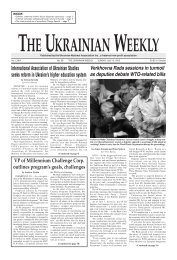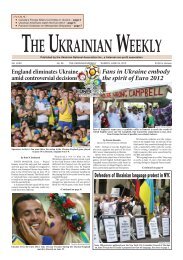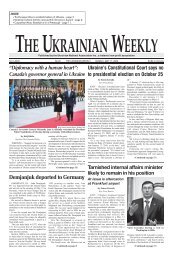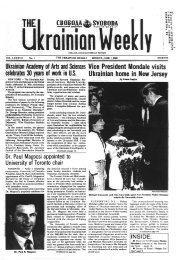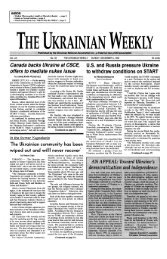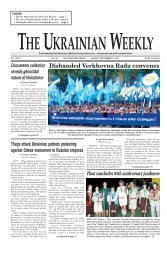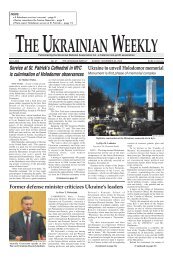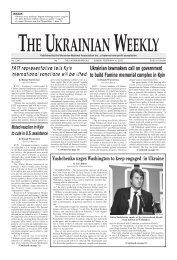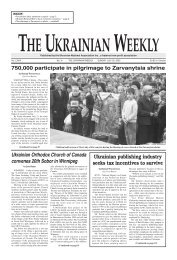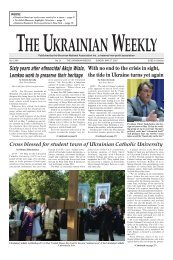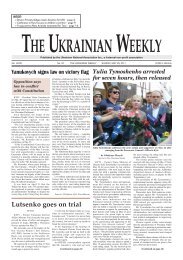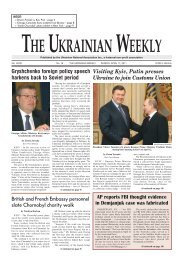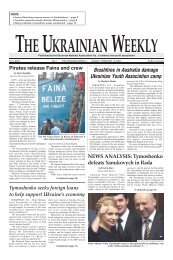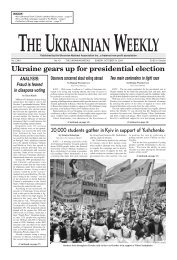1_January 6, 2002 - The Ukrainian Weekly
1_January 6, 2002 - The Ukrainian Weekly
1_January 6, 2002 - The Ukrainian Weekly
Create successful ePaper yourself
Turn your PDF publications into a flip-book with our unique Google optimized e-Paper software.
4 THE UKRAINIAN WEEKLY SUNDAY, JANUARY 6, <strong>2002</strong><br />
No. 1<br />
FOC US ON PHILATELY<br />
PHI<br />
by Ingert Kuzych and Lubomyr Hugel<br />
This article is dedicated to my late<br />
friend Lubomyr Hugel, who left behind<br />
an unfinished draft of an article on<br />
Ukraine’s very first stamp issue. I have<br />
incorporated some of his text into this<br />
month’s submission. – I.K.<br />
Creating the stamps<br />
Shortly after Ukraine declared its<br />
independence on <strong>January</strong> 22, 1918,<br />
prominent artists Antin Sereda and<br />
Heorhii Narbut were assigned an exciting<br />
yet daunting task – to design the first<br />
stamps of the newly independent republic.<br />
<strong>The</strong> two men proved up to the challenge<br />
and together created a five-stamp<br />
set that appropriately represented<br />
Ukraine and that saw extensive use over<br />
the next several years.<br />
<strong>The</strong> men worked in haste, and their<br />
designs were already put to use on April<br />
18 to print the first “stamps” onto card<br />
stock, not onto paper. <strong>The</strong> reason for this<br />
alteration was that these first “stamps”<br />
were in reality money-tokens. Although<br />
they resembled regular stamps and were<br />
perforated, the heavier card stock<br />
enhanced the durability of these tokens.<br />
<strong>The</strong>y were used in place of coins, since a<br />
metal shortage prevented the <strong>Ukrainian</strong><br />
government from creating any smallchange<br />
currency (Figure 1). Carried on<br />
the reverse of all these money-tokens<br />
was a <strong>Ukrainian</strong>-language inscription in<br />
black ink that read, “Circulates on par<br />
with coins” (Figure 2).<br />
Even though not intended for postal<br />
use, some money-tokens were attached to<br />
envelopes and postmarked with the collaboration<br />
of amenable postal employees.<br />
Because of their scarcity, such covers<br />
usually fetch high prices.<br />
Exactly three months later, on July 18,<br />
1918, these same designs were printed<br />
onto thin white paper to create Ukraine’s<br />
first true postage stamps. This imperforate<br />
set goes by the name of the Shahy<br />
Issue in English, because the values run<br />
from 10 to 50 shahy (Figure 3).<br />
[NB: In <strong>Ukrainian</strong>, the plural of the word<br />
“shah” is “shahy” and so the set is referred<br />
to as the Shahy Issue.] Like the earlier<br />
Money-Token Issue, each of the five values<br />
of the Shahy Issue were printed in<br />
sheets of 400 stamps, which were cut<br />
into 100-subject panes before being distributed<br />
to post offices. No inscription<br />
appeared on the reverse; instead a<br />
smooth white gum was applied.<br />
Stamp description<br />
<strong>The</strong> more one studies these stamps,<br />
which at first glance give the impression<br />
of a simple design, the more one discovers<br />
how skillfully the artists were able to<br />
create a well-balanced and appropriate<br />
work of art. All five designs can be seen<br />
to be influenced by the turn-of-the-century<br />
Art Nouveau style, which was still<br />
popular at this time. <strong>The</strong> first four stamps<br />
all incorporate Ukraine’s newly adopted<br />
emblem – the trident.<br />
by Ingert Kuzych<br />
Ukraine’s first stamp set: the shahy issue of 1918<br />
FIGURE 1. <strong>The</strong> five-value shahy money-token “stamp” set.<br />
<strong>The</strong> two low-value stamps were<br />
designed by Antin Sereda. <strong>The</strong> yelloworange<br />
10-shahy value depicts a rising<br />
sun whose rays shine onto the globe.<br />
Although impossible to accurately identify<br />
the portion of the planet being illuminated,<br />
we believe it is meant to represent<br />
Ukraine. <strong>The</strong> rather elongated land surface<br />
seems to be bisected by a southeastflowing<br />
river reminiscent of the direction<br />
of Ukraine’s Dnipro. <strong>The</strong> entire scene<br />
serves as the background for a prominent<br />
trident. A flower motif frames the left<br />
and right sides of the image.<br />
<strong>The</strong> brown 20-shahy stamp shows a<br />
farmer holding a scythe. <strong>The</strong> implement<br />
is appropriate since it was used extensively<br />
in Ukraine to cut grains, as well as<br />
to mow grasses for forage. Ukraine was<br />
the largest producer of wheat in Europe<br />
in the early part of the 20th century.<br />
<strong>The</strong> three higher values were the work<br />
of Heorhii Narbut. <strong>The</strong> ultramarine-color,<br />
30-shahy value shows the profile of a<br />
young woman wearing a wreath of flowers<br />
(an integral part of many <strong>Ukrainian</strong><br />
ladies folk costumes). <strong>The</strong> image is<br />
meant to be an allegory of Ukraine and it<br />
is the most beloved of the Shahy Issue<br />
designs. Interestingly, when Ukraine reestablished<br />
its postal service in 1992, the<br />
first definitive (standard) stamps produced<br />
were in tribute to Mr. Narbut.<br />
<strong>The</strong>y displayed a very similar octagonal<br />
profile image and even some of the same<br />
corner design elements (Figure 4).<br />
Ukraine’s trident, surrounded by a floral<br />
wreath, is the subject of the green 40shahy<br />
stamp. Tridents on <strong>Ukrainian</strong> territories<br />
date back two millennia. <strong>The</strong> symbol<br />
was adopted by the rulers of<br />
medieval Kyivan Rus’, and it is prominently<br />
displayed on the coins of that time<br />
(10th-11th centuries). <strong>The</strong> trident was<br />
twice readopted as Ukraine’s pre-eminent<br />
national emblem in the 20th century: in<br />
1918 and in 1992.<br />
Besides the bold number “50” encircled<br />
by a wreath, the red high-value stamp of<br />
this set features a post horn, the universal<br />
symbol of the postal service. Post horns<br />
were often used in the 18th and 19th centuries<br />
to signal the approach of mail-carrying<br />
carriages to postal stations.<br />
Shahy Issue stamps were printed in<br />
millions of copies and are relatively common.<br />
(A set can be had for about 75<br />
cents.) One would not expect such ordinary<br />
and inexpensive stamps to have been<br />
forged, yet they were and they turn up<br />
quite frequently in general collections and<br />
dealers’ stocks. <strong>The</strong> easiest and quickest<br />
way to identify forged shahy stamps is to<br />
examine the paper. Instead of using thin,<br />
white paper, the forger(s) printed their<br />
stamps on thin, rather shiny, light brown,<br />
semi-transparent paper, almost resembling<br />
glassine paper or thin waxed paper.<br />
Additionally, there are differences in<br />
details that readily distinguish bogus<br />
stamps from genuine; two shahy values<br />
will be examined more closely. Figure 5<br />
shows a forged 20-shahy value and contrasts<br />
it with a legitimate stamp. <strong>The</strong><br />
elongated mustache that tapers downward<br />
and touches the shading of the jaw<br />
line immediately identifies the forgery.<br />
On the other hand, bona fide stamps<br />
show a distinct white space between a<br />
curled-up mustache and jaw shading.<br />
In Figure 6, the bogus 30-shahy<br />
stamp displays lines of neck shading that<br />
are irregular, and a line, about halfway<br />
down, that protrudes noticeably to the<br />
left. A genuine Shahy Issue specimen<br />
shows shading lines that are quite regular<br />
and produce a straight, vertical edge.<br />
Conclusion<br />
Along with trident-overprinted<br />
Russian stamps (the subject of a future<br />
article), the shahy stamps served as the<br />
workhorse of the mail system throughout<br />
Ukraine’s turbulent years of independence<br />
(1918-1920). Because of their<br />
unpretentiousness, these stamps are usually<br />
taken for granted or even ignored<br />
(amazingly, very few articles or studies<br />
have been written about the Shahy<br />
Issue). It is our hope that this situation<br />
will soon change and that these stamps<br />
(and the related money-tokens) will<br />
FIGURE 3. <strong>The</strong> five stamps of the Shahy Issue.<br />
acquire the prominence they deserve as<br />
some of Ukraine’s first manifestations of<br />
independence and of national character.<br />
Ingert Kuzych may be contacted at P.O.<br />
Box 3, Springfield, VA 22150 or at his email<br />
address: ingert@starpower.net.<br />
FIGURE 2. <strong>The</strong> inscription on the<br />
reverse of the money-tokens reads:<br />
“Circulates on par with coins.”<br />
FIGURE 4. First day cover from May 16, 1992, shows Ukraine’s new definitive stamp<br />
set, modeled after the 30-shahy value from 1918.<br />
FIGURE 5. Forged and genuine 20-shahy stamps; note differences in the mustache.<br />
FIGURE 6. Forged and genuine 30-shahy stamps; note differences in the neck shading.



